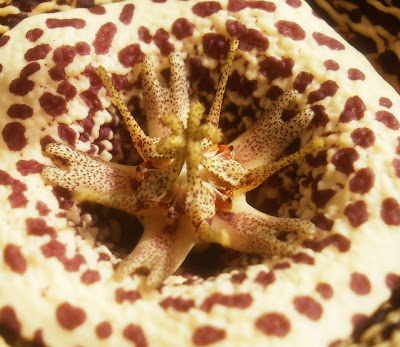This is the Stapelia variegata (more correctly Orbea variegata) I got from Cactus Jungle earlier this summer.
I'd said at the time that I didn't necessarily expect flowers ever, but I'd given it an outdoor spot, and we'd see what happened. Then at the beginning of September, I saw a couple buds:
And then there was an agonizing couple weeks while I waited for them to develop enough to open and hoped that they wouldn't fall off. At some point during this wait, I noticed the plant had grown a lot in the three months it's been here. I hadn't realized how small it was to begin with.
It also lost the red color it had when it arrived, as you can see. That was never very likely to last, considering how little light I can offer indoors, though I'm surprised that it couldn't keep the color on the west side of a house, outdoors, in a summer when it almost never rained.
In any case, the flower finally opened on 18 September, and it was worth the wait:
It's only about 2.5 in / 7 cm in diameter, much smaller than the S. gigantea flower. The smell was similar to S. gigantea: unpleasant, but not strong enough to be detectable outside a fairly small radius of the plant, though flies seemed to find it just fine. (In the ten minutes or so that I had it out in front of the house to get pictures, there were at least five flies buzzing around it. None ever actually landed on the flower while I was taking pictures, which is just as well for my purposes but makes me wonder whether the flower was perhaps not fully charged yet, or something. They may also have just been confused about the location: it was a windy morning.)
As is customary with Stapelia blooms, I let Sheba sniff it for a while. She was very interested, and sniffed pretty long and hard, then pronounced it plodding and pedestrian, without the playful, impish notes of squirrel carrion or the complexity and layering of feces. She'd been more enthusiastic about the S. gigantea smell. This will probably be the last time I ask her for a stapeliad review.
The back of the flower reminds me a bit of a hellebore:
The plant has a good six or seven more buds on it. This is a little worrisome. One flower's smell isn't intolerable, but I don't know what two, or four, might be like. The most compelling reasons to allow multiple buds to open simultaneously would be for 1) pictures and 2) the opportunity to get some seed pods. As for the latter: a quick skim of this page, which goes into considerable botanical detail about how stapeliads are pollinated, only revealed that it's too complicated to figure out from a quick skim. We have a lot of houseflies that have been trying to take shelter in the house, as the days have gotten colder; I may just leave the matter in their capable















